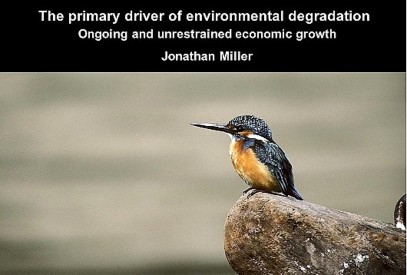The primary driver of environmental degradation

To improve Australia’s natural environment, we first need to recognise and address the drivers of its degradation.
The delayed release of the 2021 national State of the Environment report helped to dramatically increase its profile. The new federal government was able to characterise the opposition as trying to bury a damning report which highlighted its nine years of environmental neglect. While the report does indeed paint a sobering picture, none of its account of degradation and loss is news to ecologists. Our parlous environmental predicament is the outcome of over two centuries of unsustainable economic use of our continent.
The headline from the State of the Environment report is that “Overall, the state and trend of the environment of Australia are poor and deteriorating as a result of increasing pressures from climate change, habitat loss, invasive species, pollution and resource extraction.” This edition of the five-yearly report highlights the importance of environmental quality for human health and economic prosperity. This is significant, because environmental issues are frequently trivialised as sentimental or aesthetic concerns – involving beautiful landscape or cute, furry mammals – and secondary to ‘more serious’ economic concerns.
The report goes further to warn that “Environmental degradation is now considered a threat to humanity, which could bring about societal collapses with long-lasting and severe consequences.” This stark sentence is the more extraordinary for the fact it was drafted by normally cautious scientists and appears in an Australian government report. It echoes the key message the Club of Rome’s Limits to Growth, released fifty years ago.
Limits to Growth provides an important framework for understanding how our natural systems reached their current state, because it prompts us to consider the drivers of this damage. Government environmental policy has generally been targeted, if ineffectively, at addressing the immediate causes of degradation, such as carbon emissions and vegetation clearing.
The new federal Australian government has announced that it will improve Federal environmental legislation, which is welcome, however that will not address the underlying causes of environmental degradation. As manager of the national threatened species program, I saw this disparity daily. Governments would approve environmentally destructive projects and then provide minimal funding to recover the species those projects were pushing towards extinction.
There are many drivers of environmenttal degradation in Australia but foremost is our unquestioned commitment to ongoing economic growth.
The 2016 national State of the Environment noted that “In Australia, the key drivers of environmental change are population and economic activity.” Population is, of course, a major factor in Australian economic growth, if not per capita economic growth. The 2021 State of the Environment report finds that population growth is a major driver of “many pressures on biodiversity” and that its impacts are “extensive and increasing in many areas.”
Another important related driver is our society’s dualistic mental separation from the environment – seeing the natural world as ‘other’. This perspective is reinforced by the framing of the natural environment by neoclassical economics as primarily an input to economic production. From this mindset, it is possible to regret environmental loss but to rationalise it as a necessary consequence of societal progress. This Cartesian dualistic perspective and our colonial history predispose Australians towards accepting a highly extractivist economy.
While the new federal government remains committed to economic growth and ‘Big Australia’, its introduction of Wellbeing Budgeting is a small step towards shifting its priorities away from economic growth as an unquestioned goal, with no clear purpose or assessment of consequences, to focusing on more direct measures of societal wellbeing.
Jonathan Miller is an ERA member living in ACT, and former manager of the national threatened species program.






























Pingback:Economic Reform Australia Review article: The Primary Driver of Environmental Degradation - Steady State ACT